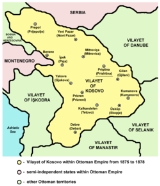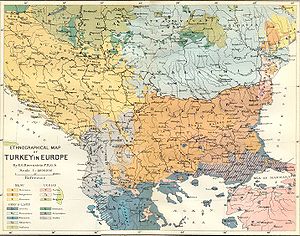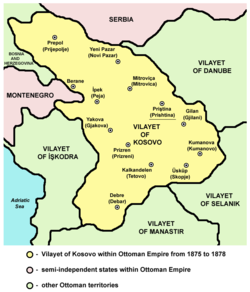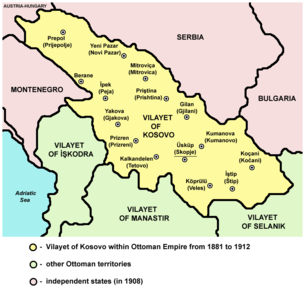
History of Ottoman Kosovo
Encyclopedia

Kosovo
Kosovo is a region in southeastern Europe. Part of the Ottoman Empire for more than five centuries, later the Autonomous Province of Kosovo and Metohija within Serbia...
was part of the Ottoman Empire
Ottoman Empire
The Ottoman EmpireIt was usually referred to as the "Ottoman Empire", the "Turkish Empire", the "Ottoman Caliphate" or more commonly "Turkey" by its contemporaries...
from 1455 to 1912, at first as part of the eyalet
Eyalet
Eyalets were a former primary administrative division of the Ottoman Empire. The term is sometimes translated province or government. Depending on the rank of their commander, they are also sometimes known as pashaliks, beylerbeyliks, and kapudanliks.From 1453 to the beginning of the nineteenth...
of Rumelia
Rumelia
Rumelia was an historical region comprising the territories of the Ottoman Empire in Europe...
, and from 1864 as a separate Kosovo Vilayet.
During this period several administrative districts (known as sanjak
Sanjak
Sanjaks were administrative divisions of the Ottoman Empire. Sanjak, and the variant spellings sandjak, sanjaq, and sinjaq, are English transliterations of the Turkish word sancak, meaning district, banner, or flag...
s ("banners" or districts) each ruled by a sanjakbey (roughly equivalent to "district lord") have included parts of the territory as parts of their territories.
History
In 1689 Kosovo was greatly disrupted by the Great Turkish WarGreat Turkish War
The Great Turkish War refers to a series of conflicts between the Ottoman Empire and contemporary European powers, then joined into a Holy League, during the second half of the 17th century.-1667–1683:...
(1683-1699), in one of the pivotal events in Serbian national mythology. In October 1689, a small Habsburg
Habsburg Monarchy
The Habsburg Monarchy covered the territories ruled by the junior Austrian branch of the House of Habsburg , and then by the successor House of Habsburg-Lorraine , between 1526 and 1867/1918. The Imperial capital was Vienna, except from 1583 to 1611, when it was moved to Prague...
force under Margrave
Margrave
A margrave or margravine was a medieval hereditary nobleman with military responsibilities in a border province of a kingdom. Border provinces usually had more exposure to military incursions from the outside, compared to interior provinces, and thus a margrave usually had larger and more active...
Ludwig of Baden breached the Ottoman Empire and reached as far as Kosovo, following their earlier capture of Belgrade
Belgrade
Belgrade is the capital and largest city of Serbia. It is located at the confluence of the Sava and Danube rivers, where the Pannonian Plain meets the Balkans. According to official results of Census 2011, the city has a population of 1,639,121. It is one of the 15 largest cities in Europe...
. Many Serbs and Albanians pledged their loyalty to the Austrians
Austrians
Austrians are a nation and ethnic group, consisting of the population of the Republic of Austria and its historical predecessor states who share a common Austrian culture and Austrian descent....
, some joining Ludwig's army. This was by no means a universal reaction; many other Serbs and Albanians fought alongside the Ottomans to resist the Austrian advance. A massive Ottoman counter-attack the following summer drove the Austrians back to their fortress at Niš
Niš
Niš is the largest city of southern Serbia and third-largest city in Serbia . According to the data from 2011, the city of Niš has a population of 177,972 inhabitants, while the city municipality has a population of 257,867. The city covers an area of about 597 km2, including the urban area,...
, then back to Belgrade
Belgrade
Belgrade is the capital and largest city of Serbia. It is located at the confluence of the Sava and Danube rivers, where the Pannonian Plain meets the Balkans. According to official results of Census 2011, the city has a population of 1,639,121. It is one of the 15 largest cities in Europe...
, then finally back across the Danube
Danube
The Danube is a river in the Central Europe and the Europe's second longest river after the Volga. It is classified as an international waterway....
into Austria.


Patriarch
Originally a patriarch was a man who exercised autocratic authority as a pater familias over an extended family. The system of such rule of families by senior males is called patriarchy. This is a Greek word, a compound of πατριά , "lineage, descent", esp...
of the Serbian Orthodox Church - to flee along with the Austrians. This event has been immortalised in Serbian history as the Velika Seoba or "Great Migration". It is traditionally said to have accounted for a huge exodus of hundreds of thousands of Serbian refugees from Kosovo and Serbia proper, which left a vacuum filled by a flood of Albanian immigrants. Arsenije himself wrote of a figure of "30,000 souls" (i.e. individuals) who fled with him to Austria, a figure confirmed by other sources.
National awakening
In 1878, one of the four vilayets with Albanian inhabitants that formed the League of PrizrenLeague of Prizren
The League for the Defense of the Rights of the Albanian Nation commonly known as the League of Prizren was an Albanian political organization founded on 10 June 1878 in Prizren, in the Kosovo province of the Ottoman Empire....
was Vilayet of Kosovo. The League's purpose was to resist both Ottoman rule and incursions by the newly-emerging Balkan nations.
In 1910, an Albanian-organised insurrection broke out in Pristina
Pristina
Pristina, also spelled Prishtina and Priština is the capital and largest city of Kosovo. It is the administrative centre of the homonymous municipality and district....
and soon spread to the entire vilayet of Kosovo, lasting for three months. The Ottoman sultan visited Kosovo in June 1911 during peace settlement talks covering all Albanian-inhabited areas.
Islamisation
Despite the imposition of MuslimMuslim
A Muslim, also spelled Moslem, is an adherent of Islam, a monotheistic, Abrahamic religion based on the Quran, which Muslims consider the verbatim word of God as revealed to prophet Muhammad. "Muslim" is the Arabic term for "submitter" .Muslims believe that God is one and incomparable...
rule, large numbers of Christian
Christian
A Christian is a person who adheres to Christianity, an Abrahamic, monotheistic religion based on the life and teachings of Jesus of Nazareth as recorded in the Canonical gospels and the letters of the New Testament...
s continued to live and sometimes even prosper under the Ottomans. A process of Islamisation began shortly after the beginning of Ottoman rule but it took a considerable amount of time - at least a century - and was concentrated at first on the towns. It appears that many Christian Albanian inhabitants converted directly to Islam, rather than being replaced by Muslims from outside Kosovo. A large part of the reason for the conversion was probably economic and social, as Muslims had considerably more rights and privileges than Christian subjects. Christian religious life nonetheless continued, with churches largely left alone by the Ottomans, but both the Serbian Orthodox
Serbian Orthodox Church
The Serbian Orthodox Church is one of the autocephalous Orthodox Christian churches, ranking sixth in order of seniority after Constantinople, Alexandria, Antioch, Jerusalem, and Russia...
and Roman Catholic churches and their congregations suffered from high levels of taxation.
Ethnic composition
.jpg)
Sandžak
Sandžak also known as Raška is a historical region lying along the border between Serbia and Montenegro...
region of southern Serbia, northwest of Kosovo. Some historians believe that there was probably a pre-existing population of probably Catholic Albanians in Metohia who mostly converted to Islam, but remained strictly a minority in a still largely Serb-inhabited region.

